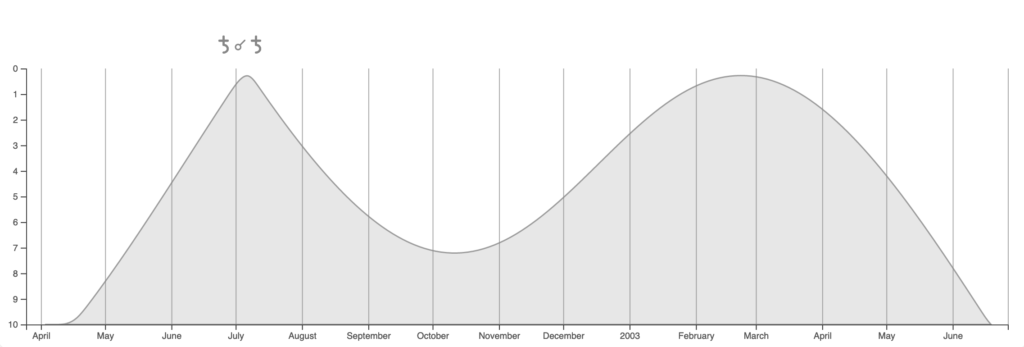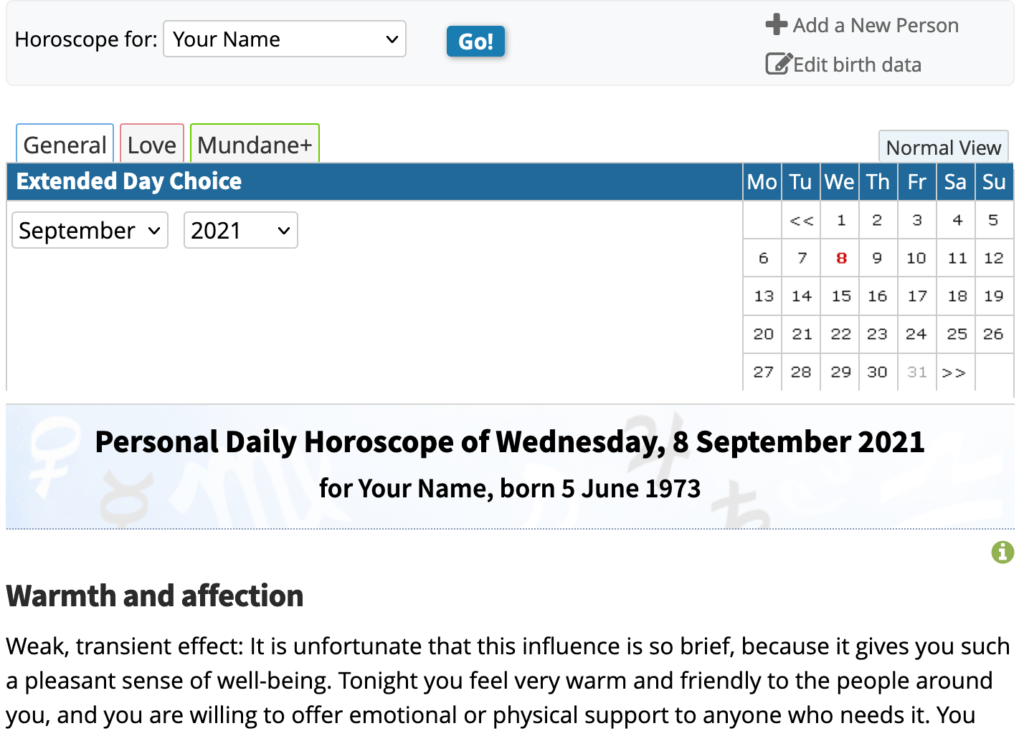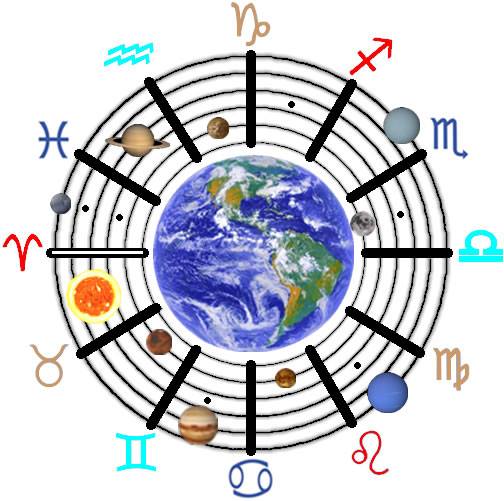In DIY Astrology Part 1, we covered your birth chart and how to explore it using the website AstroDienst. In this entry, we’ll cover Transits and how to follow the sheet music of our lives.
It can be challenging to decipher the difference between who we are and what we’re going through. Even as the events of life change us, some aspects of our identity remain consistent. For our parents, our birth was one of many events in their lives. But for us, it was our very first event. Invite-only; dress: optional. We may arrive early or right on time, but when we make our big entrance, all the planets pose for a group picture to celebrate the occasion. This snapshot of the planets is our Natal Chart, the ultimate Selfie! But the planets never cease their careful choreography. And as they dance to the music of the spheres, they compel us to dance along.

Our spirit is like a fine wine, bottled and corked on the day of our birth. The bottle contains the essence of that moment, carrying it through time, preserving it as it ages. In a way, a wine bottle merely contains an astringent liquid beverage. But in another very significant way, it holds a specific moment in time. This is why the connoisseurs of fine wine speak of good and not-so-good years for wine; they know that they are literally consuming the moment of the date on the bottle. We are the time and place we were born, moving through space as time goes by. And our Transits describe our journey from one moment to the next.
Major Transits
Transits act just like Aspects in our Natal Charts, but they last only for a time. The best example of a transit is our birthday, or Sun conjunct Natal Sun (☉ ☌ ☉). On our birthday, the Sun transits the same degree it occupied at our birth, representing the completion of one cycle and the beginning of a new one. As the Sun moves around the zodiac each year, it makes every Major Aspect to its Natal position. The Sun moves approx. 1° each day, so every 30° interval is approx. one month. Therefore, Sun square Natal Sun occurs about three months after (and before) our birthday. And Sun oppose Natal Sun occurs about six months after (or before) our birthday.
Sun conjunct Natal Sun (☉ ☌ ☉) 0°
Sun sextile Natal Sun (☉ ∗ ☉) 60°
Sun square Natal Sun (☉ □ ☉) 90°
Sun trine Natal Sun (☉ △ ☉) 120°
Sun opposite Natal Sun (☉ ☍ ☉) 180°
Sun trine Natal Sun (☉ △ ☉) 120°/240°
Sun square Natal Sun (☉ □ ☉) 90°/270°
Sun sextile Natal Sun (☉ ∗ ☉) 60°/300°
Sun conjunct Natal Sun (☉ ☌ ☉) 0°/360°

As the Sun moves through its annual cycle, it makes every aspect to the planets and angles in our Natal charts. Each planet makes every possible aspect as they move through their cycles on their unique timescales. What takes the Sun all year, takes the Moon only 28 days. But Saturn takes about 29 long years to complete the same sequence. If we live to be 84 years old, we will experience one complete Uranus cycle, and thus, every Uranus transit. But even if we live to be 100+ years old, we will never experience an entire Neptune or Pluto cycle. Though every cycle repeats, this complex choreography is constantly churning out a unique combination of events.
Orbs
The term “Orb” refers to the time it takes a transit to build, peak, and ultimately resolve. Events don’t just happen; they build over time, often beneath the surface of our experience. We may be surprised by an event, but there are usually warning signs if we’re paying attention. We know some events are coming, and we may dread them or be looking forward to them. What some people refer to as their “Birthday week” is an excellent example of an orb. We’re not just looking forward to our birthday; we can already feel that special birthday feeling. We may even start demanding special treatment a few days before and after our actual birthday. Birthday Week is real, but don’t push it!

Think of the orb as a volume nob. Every transit can be represented as a musical interval with a certain amount of consonance or dissonance. Some transits are pleasant and harmonious, while others are stressful and challenging. We experience this tension as very weak at first, but the volume increases as they move closer to an exact aspect. When the aspect is exact, the volume peaks, and as it moves on, the volume fades out like a song. Retrograding planets may bring the same transit back for one or two encores, and we can expect the volume to fade in and out accordingly. Depending on the transiting planet, these tense moments can last as long as a few hours to a few years.

Universal Transits
When we compare the current planetary positions to our Natal Charts, we’re exploring our personal transits (☉ ☌ ☉). The first planet represents a current planetary position, and the second planet represents one of our Natal planets. This is how we can have two Suns in one transit, our Natal Sun being hypothetical. When we speak of Universal Transits, there can only be one of each planet. Because all planets are in constant motion at varying speeds, the faster-moving planet always transits the slower one. Whereas, any planet can transit a (fixed) Natal planet.

We find the best examples of Universal Transits in the lunar cycle with the New Moon (☽ ☌ ☉), Full Moon (☽ ☍ ☉), and Quarter Moons (☽ □ ☉). These transits all occur at the same time for everyone on the planet. However, it would be inaccurate to suggest that we all experience them in the same way. New Moons and Full Moons happen at regular intervals but in different degrees of the zodiac. We may have a strong reaction to a Full Moon that conjuncts our Natal Sun and little or no response to one that doesn’t aspect any of our Natal positions. But if we happen to be born during a Full Moon, we will carry the qualities of that transit with us as one of our Natal aspects.
AstroDienst
If you haven’t already entered your birth information into the AstroDienst website, you can follow the instructions here. For the Full AstroDienst Experience, I highly recommend purchasing a subscription to the Extended Daily Horoscope. I also recommend purchasing the book “Planets in Transit” by Rob Hand, where you’ll find the Transit interpretations used by AstroDienst in their Daily Horoscopes. Once we have our birth data entered, we can begin to explore our Transits.

Go to the “Horoscopes” page and click on “Personal Daily Horoscope,” make sure the drop-down list has your name or the correct name if you’re looking at someone else’s transits. The website will show one transit interpretation with information about the timing of that transit. Below that, you will see a list of other transits for the day and their exact times. Once you have read the displayed interpretation, you can click each one below to read those. Below these, you will see three long-term transits that are not exact today but have very long periods of influence. For a collection of current long-term Transits, go to “Horoscopes” and click on “Short Report Forecast.”

There are so many transits overlapping at any given time that it can be challenging to consider the complex combination of influences. By following your Transits on AstroDienst, you’ll be much more in tune with the sheet music of your life. But just like our Natal Charts, a professional astrologer is able to put it all into a context we can understand. Whether you want to learn more about your own sheet music or be an astrologer yourself, I recommend following your Transits on AstroDienst and getting regular Forecasts Sessions from a professional. Click Here to schedule a session.

